When my parents moved to their Surrey nursing home several years ago, my mother had to clear out her sewing and knitting things to make space in their new smaller home. She passed all these goodies on to me.
Among the many bags of wool, patterns, fabrics and threads etc was this tapestry that my father had stopped working on. Sadly towards the end of his life, he lost interest in so many things.  I put it away, along with all the other things my mother had given me, and forgot it for a while.
I put it away, along with all the other things my mother had given me, and forgot it for a while.
Then, this summer, remembering what pleasure I had had stitching tapestries in previous years over the long light days (when I can see clearly!), I looked to see what I might stitch this year. This tapestry came to hand. Sufficient time had passed since my father’s death in March 2015 for me to feel ready to pick it up again.
It was somewhat unusual for a very conventional man of his time (born in 1926) to do tapestry work, but his step-father was also a very talented stitcher, and perhaps that was what inspired my father. Whatever, in retirement, my father did a lot of tapestry work, making pieces for many members of the family. I wish I could show you a picture of him stitching, but although I have combed the family albums for such a pic, alas, I cannot find one. But I have found a pic of him knitting – KNITTING?!! I never knew he knitted! It’s a lovely happy pic of him with grand-daughter Bel. Before I could start work, it was important for me to look at his other work to pick up ideas and influences. As you’ll see, he had such a distinctive way of working. I sent a call round the family – and these are a few of the pieces that turned up.
Before I could start work, it was important for me to look at his other work to pick up ideas and influences. As you’ll see, he had such a distinctive way of working. I sent a call round the family – and these are a few of the pieces that turned up.
This tapestry cushion was made for my uncle and aunt’s wedding anniversary in 1980, and now belongs to their daughter, Polly. It’s very characteristic of his work in that he includes initials, dates – and lots of Latin, Greek and Japanese quotes (all languages he was very familiar with). He’s made a most distinctive feature of the Japanese character at the centre – very bold, and very effective. I don’t need to offer any translation, because Polly had the initiative to ask him for one – Brilliant foresight, Polly!
I don’t need to offer any translation, because Polly had the initiative to ask him for one – Brilliant foresight, Polly! 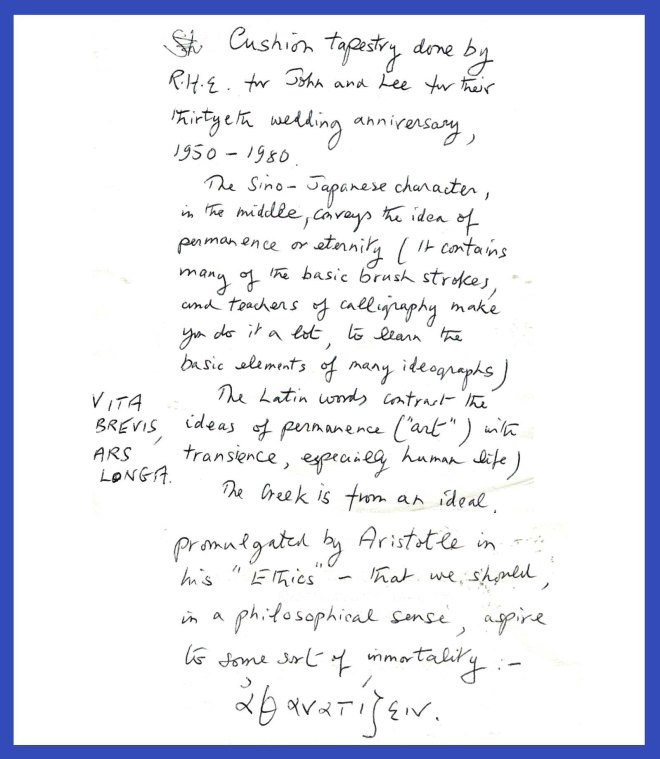 Another early piece (also of his own design) is this cushion which he made for me in 1982 to mark the occasion when I gave up smoking (and oh, boy, was I a dedicated smoker, so it was indeed a big occasion – and shared especially with my father as he too had given up smoking a long way back). You can see how very skilled he was in featuring words and characters. The Greek text at the centre – πᾶς γὰρ νοῦς αἱρεῖται τὸ βέλτιστον ἑαυτῷ – is from Aristotle’s Nichomachean Ethics: Everyone chooses the right path for themselves. According to my father, the Japanese characters round the side mean: Good health. No smoking. This cushion is very dear to me.
Another early piece (also of his own design) is this cushion which he made for me in 1982 to mark the occasion when I gave up smoking (and oh, boy, was I a dedicated smoker, so it was indeed a big occasion – and shared especially with my father as he too had given up smoking a long way back). You can see how very skilled he was in featuring words and characters. The Greek text at the centre – πᾶς γὰρ νοῦς αἱρεῖται τὸ βέλτιστον ἑαυτῷ – is from Aristotle’s Nichomachean Ethics: Everyone chooses the right path for themselves. According to my father, the Japanese characters round the side mean: Good health. No smoking. This cushion is very dear to me. I don’t remember this Viking cushion below commemorating any particular event (sadly wonky – I have taken the pillow out to reveal the text and side patterning but it does not really show the cushion to its best). It’s interesting because it shows a change in his style of working. At some point, he started to purchase pre-designed tapestries, but continued to make them his own with the quotes and initials that he added. What prompted him to add, I wonder, La vie est trop, trop est pas assez (Life is too much, and yet not enough) and La Vie et un poème, un poème inachevé? (Roughly meaning life is like an incomplete poem, not going as one would wish.)
I don’t remember this Viking cushion below commemorating any particular event (sadly wonky – I have taken the pillow out to reveal the text and side patterning but it does not really show the cushion to its best). It’s interesting because it shows a change in his style of working. At some point, he started to purchase pre-designed tapestries, but continued to make them his own with the quotes and initials that he added. What prompted him to add, I wonder, La vie est trop, trop est pas assez (Life is too much, and yet not enough) and La Vie et un poème, un poème inachevé? (Roughly meaning life is like an incomplete poem, not going as one would wish.) The other striking thing about this Viking tapestry is that he started to break tapestry rules here. I cannot trace the original kit, but I am sure that the designers did not encourage stitchers to work those wheels in that casual manner. And look at the freehand patterning in the border just below the wheels! How very effective!
The other striking thing about this Viking tapestry is that he started to break tapestry rules here. I cannot trace the original kit, but I am sure that the designers did not encourage stitchers to work those wheels in that casual manner. And look at the freehand patterning in the border just below the wheels! How very effective! One of his finest tapestries is this piece which he made for my mother to celebrate their ruby wedding anniversary on 25th October 1992 – alas, so difficult to photograph because it is behind glass. On the back he has stuck a note (that’s so typical of my father) informing us that he bought the kit in Esztergom in Hungary in 1988. It’s a beautiful design, but how much lovelier it is for my father’s addition in Latin: Uxori JME Dilectissimae. (for my most delightful wife JME) He’s smuggled his initials (RHE) into the piece too …
One of his finest tapestries is this piece which he made for my mother to celebrate their ruby wedding anniversary on 25th October 1992 – alas, so difficult to photograph because it is behind glass. On the back he has stuck a note (that’s so typical of my father) informing us that he bought the kit in Esztergom in Hungary in 1988. It’s a beautiful design, but how much lovelier it is for my father’s addition in Latin: Uxori JME Dilectissimae. (for my most delightful wife JME) He’s smuggled his initials (RHE) into the piece too …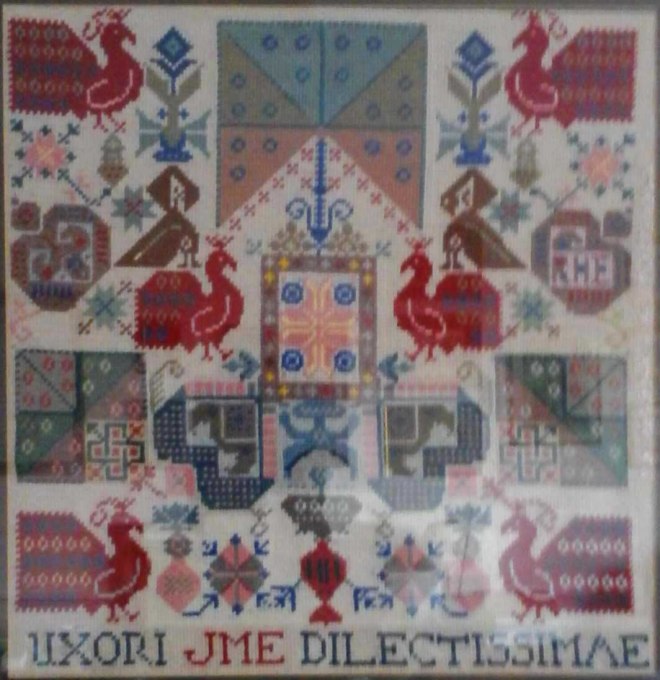 And this is a beautiful tapestry that he did for my cousin’s wedding in 1994. Again a pre-designed pattern to which he’s added their names and the date.
And this is a beautiful tapestry that he did for my cousin’s wedding in 1994. Again a pre-designed pattern to which he’s added their names and the date. He obviously liked ducks because two of his granddaughters got duck embroideries from him! This is the one he stitched for granddaughter Bel in 2000. A fine duck embroidery. I couldn’t translate the Japanese character, but I am indebted to Robin for her very helpful comment below this blog that “The character in the lower left corner of the duck tapestry represents “snipe”, pronounced “shigi” (with a hard ‘g’). If you see that the character has both a left-hand and right-hand side, the right-hand side can also stand alone, representing “bird”, pronounced “tori”.” Such a pleasure to know my father’s purpose in adding this character – thank you, Robin, very much indeed!
He obviously liked ducks because two of his granddaughters got duck embroideries from him! This is the one he stitched for granddaughter Bel in 2000. A fine duck embroidery. I couldn’t translate the Japanese character, but I am indebted to Robin for her very helpful comment below this blog that “The character in the lower left corner of the duck tapestry represents “snipe”, pronounced “shigi” (with a hard ‘g’). If you see that the character has both a left-hand and right-hand side, the right-hand side can also stand alone, representing “bird”, pronounced “tori”.” Such a pleasure to know my father’s purpose in adding this character – thank you, Robin, very much indeed! And my daughter Helen got this one which most conveniently lives with me so I was able to refer to it for patterns and designs for my project.
And my daughter Helen got this one which most conveniently lives with me so I was able to refer to it for patterns and designs for my project. Two more fine tapestry cushions live with my sister in Cumbria. This beautiful 1981 work is a wonderful mix of patterned motifs and borders set in a particularly lovely colourway – and with the usual sprinkle of quotations. I couldn’t translate the Japanese character in the centre, but I have been informed by cousin Hermione that this character means truth or reality. As for the Greek, thanks to her sister, Katy, I now know that it is from the Corpus Hermeticum: God is without sin; it is we who are sinful. Not biblical (as I originally thought) but from the Gnostic tradition. (Perhaps a more fitting biblical quote might be: Do not store up for yourselves treasures on earth, where moth and rust destroy – can you see that tell-tale hole? )
Two more fine tapestry cushions live with my sister in Cumbria. This beautiful 1981 work is a wonderful mix of patterned motifs and borders set in a particularly lovely colourway – and with the usual sprinkle of quotations. I couldn’t translate the Japanese character in the centre, but I have been informed by cousin Hermione that this character means truth or reality. As for the Greek, thanks to her sister, Katy, I now know that it is from the Corpus Hermeticum: God is without sin; it is we who are sinful. Not biblical (as I originally thought) but from the Gnostic tradition. (Perhaps a more fitting biblical quote might be: Do not store up for yourselves treasures on earth, where moth and rust destroy – can you see that tell-tale hole? ) It’s a challenge to do justice to this next cushion because the writing sits on the rounded border. Many thanks to Hermione, I know now that the Japanese characters refer to the seasons. Top left is spring, top right is summer, bottom left is autumn and bottom right is winter. That fits so well with the Latin. It’s from a very famous Horace poem Diffugere nives (The snows have fled), and has a familiar melancholy tinge: Immortalia ne speres, monet annus et almum quae rapit hora diem. (Housman’s translation is most elegant: The swift hour and the brief prime of the year Say to the soul, Thou was not born for ay.) A particularly lovely cushion, I think – and Horace was a favourite poet of his.
It’s a challenge to do justice to this next cushion because the writing sits on the rounded border. Many thanks to Hermione, I know now that the Japanese characters refer to the seasons. Top left is spring, top right is summer, bottom left is autumn and bottom right is winter. That fits so well with the Latin. It’s from a very famous Horace poem Diffugere nives (The snows have fled), and has a familiar melancholy tinge: Immortalia ne speres, monet annus et almum quae rapit hora diem. (Housman’s translation is most elegant: The swift hour and the brief prime of the year Say to the soul, Thou was not born for ay.) A particularly lovely cushion, I think – and Horace was a favourite poet of his. So it was with all these very distinctive tapestries in mind that I picked up my father’s work earlier this summer. My first task was to find some proverb or poetry to add to the piece. I searched through poetry books, collections of quotations, and then suddenly I saw it – why up there on my noticeboard! Almost top right.
So it was with all these very distinctive tapestries in mind that I picked up my father’s work earlier this summer. My first task was to find some proverb or poetry to add to the piece. I searched through poetry books, collections of quotations, and then suddenly I saw it – why up there on my noticeboard! Almost top right.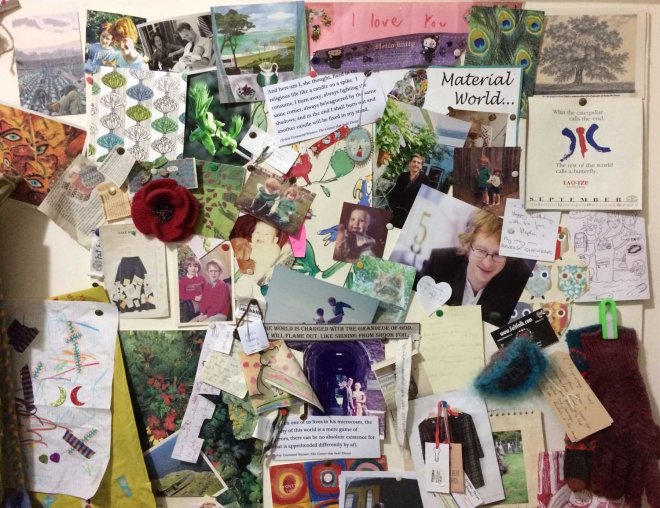 No need of the list – the lines from Lao-Tze were just perfect: What the caterpillar calls the end, The rest of the world calls a butterfly. It related to the picture, and there were just the right amount of words for me to fit them around the embroidered butterfly.
No need of the list – the lines from Lao-Tze were just perfect: What the caterpillar calls the end, The rest of the world calls a butterfly. It related to the picture, and there were just the right amount of words for me to fit them around the embroidered butterfly. Now for some elaborate calculations to work out exactly how to fit the words to the tapestry. I decided to use the same font as that used on his Viking cushion.
Now for some elaborate calculations to work out exactly how to fit the words to the tapestry. I decided to use the same font as that used on his Viking cushion.  So now for a bit of stitching …
So now for a bit of stitching …
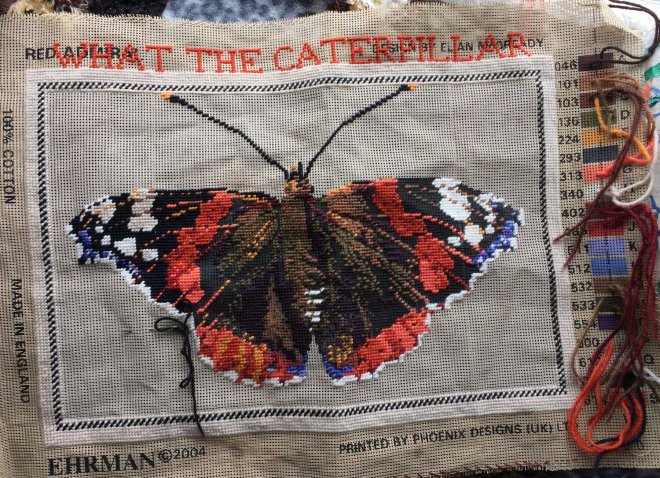 With the Lao-Tze text surrounding the butterfly completed, I was ready to think what more I might add to his embroidery. I knew that I wanted to add some words that explained how I was finishing what my father had started. This time there was less room for expansive text so I consulted an old book of embroidery designs that I had given my father for Christmas in 1979 (also part of my mother’s gifted treasure trove) …
With the Lao-Tze text surrounding the butterfly completed, I was ready to think what more I might add to his embroidery. I knew that I wanted to add some words that explained how I was finishing what my father had started. This time there was less room for expansive text so I consulted an old book of embroidery designs that I had given my father for Christmas in 1979 (also part of my mother’s gifted treasure trove) … And came up with this: Started by RHE c 2000. Finished by KMD 2017.
And came up with this: Started by RHE c 2000. Finished by KMD 2017. I thought that would fit in nicely in the space between the butterfly and the lower border.
I thought that would fit in nicely in the space between the butterfly and the lower border. As well as this embroidery, my mother had given me all her old notes and designs. It was very moving to look through these – patterns and notes dating back to her teenage years. Here is a pattern she had copied from her childhood bedroom carpet.
As well as this embroidery, my mother had given me all her old notes and designs. It was very moving to look through these – patterns and notes dating back to her teenage years. Here is a pattern she had copied from her childhood bedroom carpet. Along with careful drawings and colour plans, there are odd bits of schoolwork …
Along with careful drawings and colour plans, there are odd bits of schoolwork … But, most usefully for me, there were also her designs for when she was first starting to make embroideries for her new husband. She had met my father in Tokyo in the early 1950s. He was a young diplomat at the British Embassy, and she was looking after her brother’s child (her brother also worked at the British Embassy).
But, most usefully for me, there were also her designs for when she was first starting to make embroideries for her new husband. She had met my father in Tokyo in the early 1950s. He was a young diplomat at the British Embassy, and she was looking after her brother’s child (her brother also worked at the British Embassy). Ah – a fine Japanese character! Just the sort of thing I could well incorporate into the butterfly tapestry! But I had no idea what it meant … Luckily, my daughter’s friend, Yuki, was able to help and with a little Instagram communication she was able to tell me that it’s a Buddhist symbol meaning good fortune, happiness and in olden times was also associated with giving alms. It was just perfect for my generous and very kind father.
Ah – a fine Japanese character! Just the sort of thing I could well incorporate into the butterfly tapestry! But I had no idea what it meant … Luckily, my daughter’s friend, Yuki, was able to help and with a little Instagram communication she was able to tell me that it’s a Buddhist symbol meaning good fortune, happiness and in olden times was also associated with giving alms. It was just perfect for my generous and very kind father. At this point I happened to put my developing embroidery on my Instagram feed, and among many interesting comments, I had one from a French friend: A quatre mains! she declared. Why just so, thank you, Isabelle, because this piece is a sort of duet. And it fits perfectly, balancing the Japanese characters on the top right so well.
At this point I happened to put my developing embroidery on my Instagram feed, and among many interesting comments, I had one from a French friend: A quatre mains! she declared. Why just so, thank you, Isabelle, because this piece is a sort of duet. And it fits perfectly, balancing the Japanese characters on the top right so well. As the embroidery progressed, I was regularly consulting the other tapestry pieces I had to hand. I’d copied the little motifs that my father had embroidered round the duck to fill in the gaps of my butterfly text (those little blue flowers amid the orange) and then I came back to these small flowery motifs again for the finishing touches. I wanted something else in all that empty space – after all, my father was known to cram patterns in very effectively!
As the embroidery progressed, I was regularly consulting the other tapestry pieces I had to hand. I’d copied the little motifs that my father had embroidered round the duck to fill in the gaps of my butterfly text (those little blue flowers amid the orange) and then I came back to these small flowery motifs again for the finishing touches. I wanted something else in all that empty space – after all, my father was known to cram patterns in very effectively! The motifs at the bottom found their homes easily,
The motifs at the bottom found their homes easily, But I struggled to work out where to put them at the top, eventually having to fiddle around with some paper cutouts.
But I struggled to work out where to put them at the top, eventually having to fiddle around with some paper cutouts.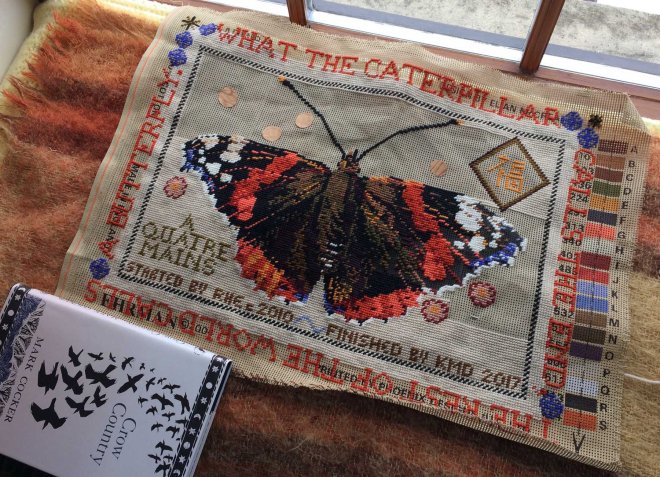 Through the lovely light summer months, there were happy days of stitching …
Through the lovely light summer months, there were happy days of stitching …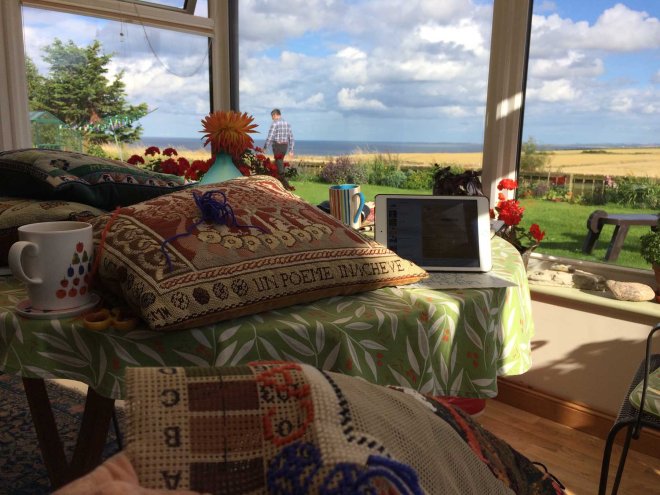 Visiting Red Admiral butterflies … a sort of blessing on my project …
Visiting Red Admiral butterflies … a sort of blessing on my project … Steadily, slowly all the background was filled in … (great train journey occupation) …
Steadily, slowly all the background was filled in … (great train journey occupation) …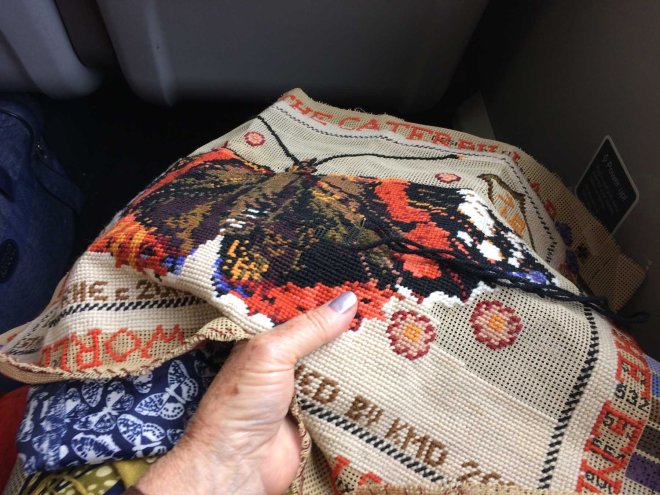 And then I just had to stitch a small border pattern.
And then I just had to stitch a small border pattern. Finally, there is was – completed!
Finally, there is was – completed! With a handsome red velvet backing.
With a handsome red velvet backing. I made a special cotton inner cushion for it, and stuffed it with clean fleece – my father would definitely approve: he loved my fleece habit!
I made a special cotton inner cushion for it, and stuffed it with clean fleece – my father would definitely approve: he loved my fleece habit! And here it is – comfortably among our other tapestry cushions …
And here it is – comfortably among our other tapestry cushions … It’s been a most happy summer stitching companion – I have so enjoyed working on this project. It’s brought back many very happy memories of my father and made me reflect on some of the ideas that were important to him – all those quotations! I think he’d pleased with what I did …
It’s been a most happy summer stitching companion – I have so enjoyed working on this project. It’s brought back many very happy memories of my father and made me reflect on some of the ideas that were important to him – all those quotations! I think he’d pleased with what I did …
(The Red Admiral butterfly tapestry was designed by Elian McCready for Ehrman Sadly she passed away in 2010.)

Absolutely love this post. How beautiful to finish a piece your father started, and analyse and emulate his style too. I love seeing all his work.
LikeLike
Thank you, Ruth. It was a really interesting challenge at first, but it became a wonderful opportunity to look at some of the amazing things he’d made – as well as provide me with a lot of very pleasurable stitching.
LikeLike
What a variety of tapestries. The butterfly is very dramatic. I have a half finished seat cover that’s been sitting in the cupboard for over twenty years because I’ve done the interesting bit in the middle and only have boring plain bits to finish. Now thinking I should emulate your father and fill the spaces with interesting details.
LikeLike
Go for it, Anne – fill the empty space with lots and lots of interesting stuff! I promise you it works 🙂
LikeLike
Now this is what is meant by an heirloom! I also love the way your father subverted the form.
LikeLike
Yes, it feels like an heirloom! I completely agree with you that it’s amazing to see how freely he worked his tapestries. I sort of think that because he’d grown up in the tradition of boys do boys’ stuff, when he took on tapestries, he didn’t have the hangovers of restraints that we women have.
LikeLike
Lovely post–both the tapestries and the shared memories of your father and your mutual love of needlework! I grew up in Japan and attended Japanese schools through 6th year so I dug out my kanji dictionary. The butterfly is exquisite, but the little ducks especially caught my eye. The character in the lower left corner of the duck tapestry represents “snipe”, pronounced “shigi” (with a hard ‘g’). If you see that the character has both a left-hand and right-hand side, the right-hand side can also stand alone, representing “bird”, pronounced “tori”. It’s fun to know these details, don’t you agree? 😊
LikeLike
Thank you, Robin – both for your kind words, and also very specially for your contribution to the translating! I wondered if that character referred to his grand-daughters as that seemed to be the common denominator in both tapestry – never thought it applied to the bird. So pleased to know a bit more about what he was trying to say – thank you very much indeed.
LikeLike
What a beautiful story and post. Your are very lucky to have had a father so talented and influential on your own creativity. He would be proud of your finish!
LikeLike
Thank you – as is ever the way I don’t think we fully appreciated his talents when he was alive. I cannot believe now that we accepted these gifts without asking why he added these words – and especially for a little translation help!
LikeLiked by 1 person
How moving to read all this, Katherine, and to see all his tapestries which I hadn’t seen before. Indeed so unusual for his time. A surprise for me – I had no idea you’d been a smoker let alone a prolific one! What a lovely celebration of your stopping. I’m going to send the Japanese ones to Hermione, who is fluent, and hope she can decipher them.
LikeLike
So glad you enjoyed it, Polly. He was an extraordinary stitcher, no doubt about it – and, as is so often the way, we really didn’t appreciate this while he was alive. Would be wonderful if Hermione could do some translation for us.
LikeLike
I really enjoyed this post. Your father’s tapestries are amazing. I love how he designed and customized patterns. It’s wonderful how you are carrying on the tradition your father began.
LikeLike
Thank you Sheryl – yes, I agree his tapestries are wonderful and I am just sad we didn’t fully appreciate that when he was alive – so often the way. I’ve never done such free tapestries before, always stuck most carefully to the instructions, so trying to copy his method was really an excellent lesson for me. Now I just wish I could find another part-completed tapestry of his to finish 🙂
LikeLike
How incredibly suitable, and how beautiful.
LikeLike
Thank you! I think my father would have approved 🙂
LikeLike
I think so too.
LikeLiked by 1 person
A beautiful tribute to your Father. I’m so glad you could pick this up and give a good nod to him as well as make this your own ❤
LikeLike
Thank you, Laura. It was a particular challenge which made it much more fun (and of course emotional) to work as he might have done – and I loved doing it. Just wish I had another unfinished tapestry of his to pick up now!
LikeLike
How amazing to find something that precious… The only crafty guy in my family is my Grandfather – he’s always making this crazy outfits from the fabric scarps, though he has a wardrobe full of new things 🙂 But ! guess he enjoys it more this way!
LikeLike
Sounds like your grandfather is quite a guy! I did feel that in a small way this blogpost is a celebration of men making stuff in what are traditionally female pursuits. These men are so great – please tell us more about your grandfather, Alina!
LikeLike
I was so touched by this story; I came across it while I was searching for images of the Red Admiral pattern, which I’m working on at the moment. Your gradfather was so creative; his work made me think of needlepoint in an entirely new way.
Do you happen to know the type face he used on the large letters (the butterfly quote)?
I’m going to subscribe to your blog. Thanks again for sharing this remembrance.
LikeLike
Thank you, Mary Ann – I am so glad to hear that you enjoyed this blogpost. It gave me such a lot of pleasure to finish his work – and judging by the comments, others have also found his work inspirational. But I’m so sorry, I don’t know what the font is – I picked it up from another cushion he’d made, but where he got that pattern from, I just don’t know.
LikeLike
I’ve just stumbled across this post and was stopped in my tracks; your work finishing your father’s tapestry is beautiful and it’s fascinating to hear about his style and design too. What a beautiful keepsake for generations to come. Thanks for sharing.
LikeLike
Thank you very much for your kind comment. This was such a special project to me – and I missed it once I’d finished! I’m so pleased to hear from you that I did justice to the story of his wonderful stitching talents 🙂
LikeLike